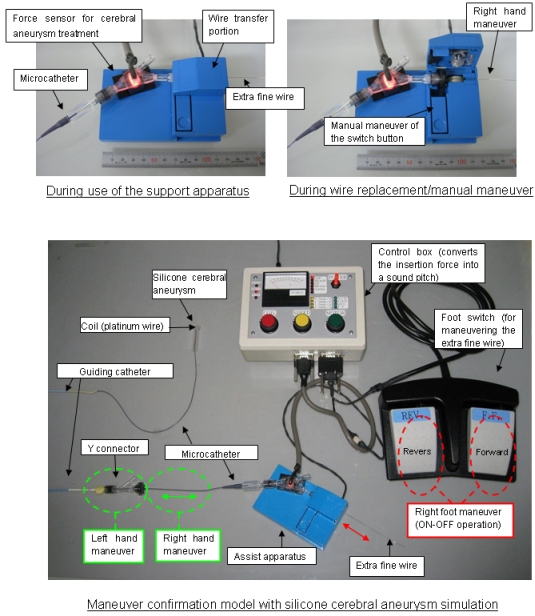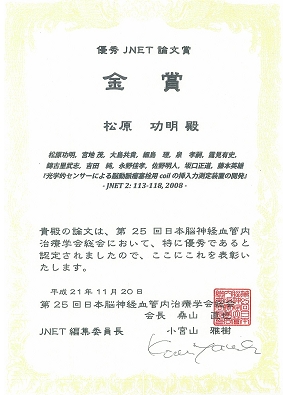
Development of “Surgical support system for cerebral aneurysm coil embolization” for use by a single doctorApril 9, 2010
[The first in the world! Assists catheter surgery for the cerebral blood vessels]
The joint research team of NTN Corporation (hereafter NTN), Fujimoto Laboratory at Graduate School of Nagoya Institute of Technology, the group of Dr. Miyachi (Associate Professor, Department of Neurosurgery, Nagoya University Graduate School of Medicine) has recently developed an apparatus for highly assisting cerebral aneurysm coil embolization conducted by a single doctor (the first in the world), in addition to the previously developed “Force sensor for cerebral aneurysm treatment”.
In the clinical practice, the number of surgical cases undergoing a catheter procedure (which is minimally invasive to the patient) is increasing. “Cerebral aneurysm coil embolization”*1, which prevents rupture of cerebral aneurysm (sac-like swelling in a part of a blood vessel), a cause of subarachnoid hemorrhage, is one of these procedures. In this surgery, a coil attached to the tip of a wire is placed inside the aneurysm to fill it by maneuvering an extra fine wire inserted into a catheter. When the wire is manipulated with an excessive force, there is a possibility of aneurysm rupture and displacement of the catheter tip into the inside of the aneurysm. Doctors have been required to insert the coil with an appropriate force to prevent such trouble and to develop skills in this procedure.
NTN has developed in 2006 the world's first “Force sensor for cerebral aneurysm treatment”*2 which measures and indicates any minimal force exerted on the extra fine wire by the fingertips of the doctor. This system has been created by the comprehensive mechatronics techniques of NTN. As a result of our continuous and repeated verification of the system in collaboration with Nagoya University School of Medicine, the effectiveness of the system acquired recognition, and the thesis reporting its development and application results has won Best paper award (Gold Medal) offered by the Japanese Society for Neuroendovascular Therapy (JNET) (November 2009).
In order to insert a coil with an appropriate force, high catheter tip positioning technique for determining the position to insert the coil is important. Since extremely superior technique and skill are required for a single doctor to simultaneously maneuver both the catheter and the wire with both hands, it is often the case that two doctors manipulate the catheter and the wire separately. In this case, the communication between the two doctors becomes very important. In some situations, the treatment needs to be done by only one doctor. Solutions to such problems have become mandatory.
The developed support apparatus facilitates the treatment by a single doctor. It allows the doctor to transfer the wire using a foot switch and a ganged motor at a constant speed which cannot be realized with fingertips, and to simultaneously position the catheter with both hands. The wire insertion force, which varies with the transfer of the wire, is measured by the force sensor for cerebral aneurysm treatment, and is converted into sound pitch (auditory) information, in addition to the conventional visual display, to be transmitted to the doctor. With this apparatus, the doctor can maneuver the coil and the catheter simultaneously while monitoring the radiographic image of the coil displayed at all times during surgery. Moreover, wire maneuver can be switched back to the conventional manual maneuver by one push on a button, ensuring high safety. In this way, this apparatus solves the problems of the conventional medical settings by realizing highly technical and sensitive assisting. Furthermore, quantification of the wire insertion force helps reduce training time of doctors. If this apparatus becomes widely used for clinical application in the future, safer and securer cerebral aneurysm embolization can be conducted.
*1 “Cerebral aneurysm coil embolization”
A plastic guide tube called a catheter is inserted from the groin through a head artery to the cerebral aneurysm, and an extra fine wire is then inserted through the catheter. A special platinum wire called a coil is attached to the tip of the extra fine wire. The cerebral aneurysm is filled with this coil to block the inside of the aneurysm and prevent rupture of the aneurysm.
*2 “Force sensor for cerebral aneurysm treatment”
The world's first system that measures and indicates any minimal force exerted on the extra fine wire by the fingertips of the doctor, which has been realized by optically detecting the displacement of the extra fine wire and visualization of the wire insertion force.
Features
| (1) Provides highly technical assistance in treatment conducted by a single doctor |
Realizes maneuver of the catheter with both hands as in the treatment conducted by two doctors |
|---|---|
| (2) Wire insertion at a constant speed |
Uniform and stable transfer by foot switch operation |
| (3) Monitors wire insertion force by sound |
Enables quantitative confirmation while focusing on the radiographic image of the coil |
| (4) Assures high safety |
Can be switched to the manual maneuver by one push |
| (5) Compact |
Can be used on the surgery table |
Inquiries about this release
Photo of apparatus

References
The thesis reporting the development results of “Force sensor for cerebral aneurysm treatment” has won Best paper award (Gold Medal) offered by the Japanese Society for Neuroendovascular Therapy (JNET). This thesis outlines the verification results of the effectiveness obtained in evaluation experiments, including accurate measurement results and the ease of use during surgery of this system. Moreover, the use of this system has provided new findings such as the features of maneuver of the coil during surgery which had been unknown until that point.
* ”Award-winning thesis“
Authors: Noriaki MATSUBARA a), Shigeru MIYACHI a), Tomotaka OSHIMA a), Osamu HOSOSHIMA a), Takashi IZUMI a), Arihito TSURUMI a), Takeshi KINKORI a), Jun YOSHIDA a), Yoshitaka NAGANO b, c), Akihito SANO b), Masamichi SAKAGUCHI b), Hideo FUJIMOTO b); Title of the thesis “Development of optical force sensor system for cerebral aneurysm coil embolization”, Neuroendovascular Therapy, Vo1. 2, pp.113-118, 2008
a) Nagoya University Graduate School of Medicine, b) Nagoya Institute of Technology Graduate School, Department of Engineering, c) NTN Corporation
Comments by the winner of the Japanese Society for Neuroendovascular Therapy (JNET) Best paper award (Gold Medal)

- Professor Hideo FUJIMOTO, Department of Engineering, Nagoya Institute of Technology Graduate School:
“The best paper award is the result of the evaluation of the system investigated and developed by the industry-university and medicine-engineering collaboration of Nagoya Institute of Technology, Nagoya University, and NTN Corporation as a support apparatus which realizes safer treatment required in medical settings. I am sure that this award winning is a step forward to achieve our goal; that is realization of “the best treatment by the best technology.” - Associate Professor Shigeru MIYACHI, Nagoya University Graduate School of Medicine:
“These research results, which greatly contribute to conducting of safe and secure cerebral endovascular treatment, were met with a great positive response from the Society. Winning the best paper award as a result is an ideal fruition of the industry-university collaboration of Nagoya Institute of Technology, Nagoya University, and NTN Corporation.”
